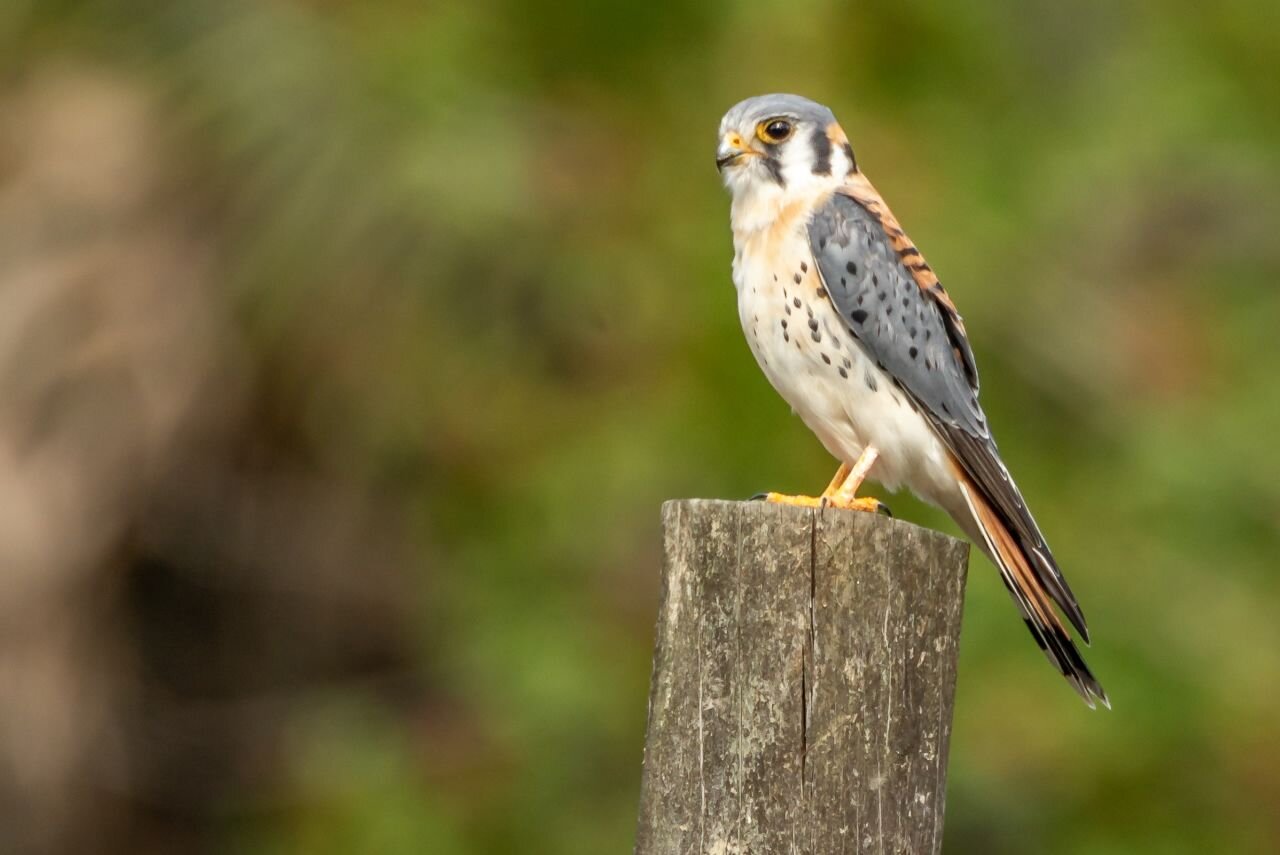“You said there are two species that are very difficult to photograph, but only showed photos of Belted Kingfishers. Where are the American Kestrel photos?” The comment came from a Hart Beat Reader after the most recent column. (“Serendipity” www.stlucieaudubon.org/hart-beat-2021 ) Oh, my goodness, photos of American Kestrels, what an excellent idea for this month’s Hart Beat column. I certainly was glad to receive that question and the implied suggestion.
Like Kingfishers, American Kestrels seem to sense when one wants to take their picture, and camera shy to the utmost, they quickly vacate the area. But just like Belted Kingfishers, American Kestrels love to perch and pose on distant posts as this male did for me. (top of page) Male Kestrels are easily distinguishable from their female counterparts, by their distinctive charcoal gray wings. But as we see in this young male Kestrel, with the lighter, just changing into full deep gray wings, males also will find a snag to sit upon, albeit, hanging on precariously (photo 2).
Female Kestrels with their all brown wings also perch precariously on snags, just as this female does while giving the viewer a questioning look seeming to say, “So what do you think you are looking at?” (photo 3) Then again, they also sit on signs, just like Kingfishers, here perusing the area where she is informed that it is legal for her to go hunting (photo 4).
I have the good fortune to have two close friends who are actively engaged in promoting the welfare of American Kestrels. They both have built and maintain a considerable number of breeding boxes, strategically placed where Kestrels are most likely to find them and nest in them, and during the breeding season monitor them regularly so that they know when eggs are laid and when the young hatch.
When the young are old enough they then return to the boxes and band the young so that they can learn where the birds migrate to and where they subsequently as adults, mate, breed and raise young of their own. (For an earlier Hart Beat column covering this procedure, see: https://static1.squarespace.com/static/5b9bd1b9697a984c75661b0f/t/5bb7c78e24a694e796d8b790/1538770836282/hb180501Banding.pdf )
When the adult female is sitting on the eggs in the box, the banders can readily lift them off the nest and simply check the Federal bands that either they or other banders have placed on the birds when they were young. In that manner they can see whether the nesting adults are birds they have previously banded or find out from the Federal banding register where and when the birds were banded by other banders.
Needless to say, it is very exciting for them to find that a bird they have banded years earlier has now found another one of their boxes, sometimes in another location many miles away, and also sometimes year after year the same bird in the same box. They also both have had the interesting experience of one of their banded birds having been recaptured by another bander using the same process, nesting years later in a similar nest box, and their previously banded bird thus reported recaptured over a thousand miles away.
When a bander is in the process of collecting the young birds for the banding process, the female Kestrel will fly quite nearby loudly squawking as she protests the bander’s actions (photo 5). From time to time she will actually turn and dive close by the bander’s head in attack mode as she continues her protest (photo 6).
Kestrels also love to perch on wires. In Florida that is where they are most commonly seen when they have migrated south for the winter. While calmly sitting on wires they are sometimes subject to attack by other bird species which may be nesting nearby and deem the Kestrels a threat, such as this Eastern Kingbird (photo 7). While the American Kestrel was formerly named Sparrow Hawk and they will occasionally eat a small bird, their diet more commonly consists of mice and voles, grasshoppers, and other insects.
American Kestrels are the smallest of American falcons, (Merlin, Peregrine and Gyrfalcon are the others) but that does not mean they have a small personality. They are fascinating birds and difficult as they are to get close to, they are very beautiful and very much worth the effort.
As with so many species American Kestrels populations are severely on the decline and it is fortunate that so many birders are making the effort to help them make a comeback. Kestrels may not be quite as difficult to photograph as Kingfishers, but getting close to them still takes quite an effort. Perhaps not serendipity as with Kingfishers, but perhaps the word for Kestrel photography is persistence. Yes, the harder one works at it the better the chance of getting a shot. Come to think of it that works pretty well for everything in life. Persistence, like serendipity, also helps make the world go round.







